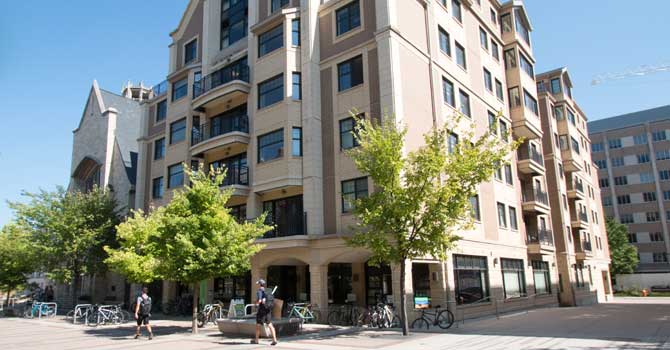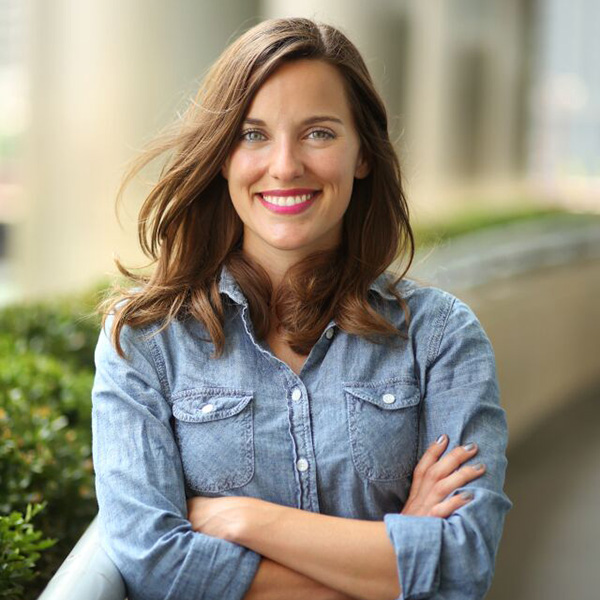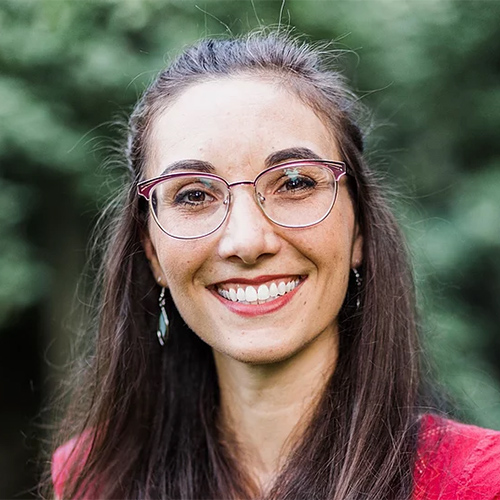It’s late afternoon on a September Sunday at the University of Wisconsin-Madison, just days before the start of the fall semester.
On a second-floor balcony of the Pres House Apartments, students sing along to music pulsing from the room behind them and toss a football back and forth to passers-by on the sidewalk below. Throughout the building, students are busy unpacking, getting their rooms organized before classes begin.
Next door, in the sanctuary of the stunning Gothic Revival church building known as Pres House, a worship band -- singers, guitarists, a pianist and a drummer -- is rehearsing for the service that will begin at 4:30. Downstairs in the fellowship hall, other students are preparing for the dinner that will follow worship.

Later, during the service, Jessica Prom, a sophomore from suburban Milwaukee, tells the congregation what Pres House and its campus ministry meant to her during her freshman year, how it became her “home away from home.”
Today, Pres House is a bustling hub of activity at UW-Madison, a combination church, campus ministry and seven-story apartment building located near the heart of the university campus. The apartments -- built in 2007 and refinanced in 2011 through an innovative arrangement with the area’s Presbyterian synod -- provide student housing while also generating funds to support the ministry.
It was not always like this. By the late 1990s, the Synod of Lakes and Prairies of the Presbyterian Church (U.S.A.), the governing body for PCUSA churches throughout the Upper Midwest, was ready to close Pres House after years of decline.
For decades, from its founding in 1907 through World War II and the 1950s, Pres House was a distinctly Presbyterian presence at the Madison campus. But then, for almost 40 years, from 1962 to 1999, Pres House dropped its exclusive Presbyterian identity and was home to a multidenominational campus ministry. By the end of the 1990s, Pres House mostly rented space to various Christian and nonprofit organizations and hosted weddings, parties, concerts and receptions.

When the synod decided to sell the building in 1999, local Presbyterians pushed back hard.
To the Rev. Kirk Morledge, then a member of the Pres House board, the synod’s proposal would mean the “annihilation” of campus ministry for Madison-area Presbyterians.
“Our energy, to a person, was to see ministry to college students not die from our church,” Morledge said.
Return to Presbyterian roots
After the synod agreed to give Pres House time to come up with an alternative, the board began a re-visioning process, eventually voting to end the ecumenical partnership and return to its roots as a Presbyterian ministry.
How does your church’s denominational identity shape its ministry?
What that ministry would look like, however, was far from certain. Looking around for successful models of Presbyterian campus ministry, the board found inspiration at the University of California, Berkeley.
There, in 2003, the Rev. Randy Bare had repurposed the Presbyterian campus ministry building, Westminster House, adding dormitory space and creating an intentional Presbyterian student community. With rents helping support the campus ministry, Westminster House became a model for church-sponsored dorms at campuses across the country.

After deciding to create a similar program and build student housing on the church parking lot, the Pres House board in 2004 hired two young pastors Bare knew at Berkeley -- the Rev. Mark Elsdon and the Rev. Erica Liu, a young married couple just starting out in ministry.
The board was upfront with them about the challenges that Pres House faced.
“They told us, ‘There are zero students, and there’s a parking lot -- see what you can do,’” Liu said.
The two pastors were unfazed.
“The reason we came here at all is because we were naive,” Elsdon said.
Elsdon and Liu got a seven-year contract from the board. Liu called it “a long runway” that would give them time and space to take risks and create something new.
The first year
That first year, in 2004, the two pastors mostly hung out around the campus, getting to know the university and its people, getting some idea of what could be.

One day not long after starting at Pres House, Elsdon was assembling the desk in his office when a student walked in, a freshman named Steve. He’d noticed the sign out front and wondered whether the “Pres” in “Pres House” meant “Presbyterian.”
“Yes, it does,” Elsdon said, continuing to work on the desk.
“What happens here?” Steve asked.
“Nothing,” Elsdon said. “Nothing happens here at all.”
As Steve gave him a puzzled look, Elsdon glanced up from the screws and tools scattered around the half-built desk.
“But if you want to help us start something, you are welcome to join us,” he said. “We are hoping to start something.”
Steve joined up, becoming the first student in the relaunched version of Pres House.
Before long, planning got underway for the construction of the apartment building and renovation of the 1931-era church structure. Feasibility studies were conducted and architects hired. To finance the $17.5 million project, Pres House raised about $600,000 in donations and borrowed the rest, issuing $16.9 million in tax-exempt bonds, backed by a letter of credit from the bank and pledging the existing church and office building as collateral.
It was risky, but risk taking was at the heart of the entire project, Liu said.
How willing is your church or organization to take risks? What’s the riskiest thing it’s ever done?
Those early years were often challenging for Elsdon and Liu, who sometimes found it difficult to sustain their energy and hope. Things were moving forward in fits and starts with no guarantee that any of it would work.
“We did this knowing it could all go to pot,” Liu said. “But we knew we had to try.”
“There was nothing to lose,” Elsdon said. “Pres House was only a few years away from being sold.”
‘Fantastic board with lots of skills’
Fortunately, Elsdon and Liu were not alone.
“We had no idea what we were doing, but we were not afraid to ask for help,” Liu said. “We had a fantastic board with lots of skills.”
The board had members who were experts in finance and in construction, including one who had overseen the building of campuses in the state’s technical college system. Even when they disagreed, the board and staff found they could work together as a team.
How well does your church use the skills and talents of members in ministry?
Any building project entails countless decisions, and the new apartments were no exception. One of the most contentious issues was the location of the laundry facilities, Elsdon said.
Outfitting each apartment with its own washer and dryer could help attract tenants, but a central laundry room on each floor could help build community. The finance people wanted individual laundries, the program people wanted community laundries, and one board member nearly quit. Ultimately, the community-laundry folks prevailed, and no one left the board.
In addition to the practical matters of construction, Elsdon and Liu had to figure out what role the apartments would play, not just as a source of funding but in the overall ministry of Pres House.
“I didn’t have energy if the only purpose was economic,” Elsdon said. “We set about trying to figure out what ministry in the building would look like.”
The apartment residents would be welcome to attend worship services, Bible study and any of the other many events at the Pres House church, but that was not what life in the apartments was to be about. Instead, Elsdon and Liu wanted to create a space that nurtured a sense of community while providing the residents with opportunities for growth -- academic, personal and spiritual.

Today, the apartments host a busy schedule of building-wide events including community dinners and weekly “afternoon tea and conversation” sessions. Residents are encouraged to participate in a variety of intentional learning programs and can earn scholarships toward their rent by, for example, serving the wider community at food pantries or Habitat for Humanity, studying broad social issues, or engaging in vocational discernment together. The apartments also offer a sober living unit for students in recovery for alcohol or drug abuse.
In 2007, all the hard work paid off. Eight years after the synod had nearly sold Pres House and four years after Elsdon and Liu arrived, the Pres House Apartments opened with space for about 240 residents in 51 units -- a mix of three-, four- and five-bedroom apartments.

A new problem
When the loan came up for renewal in 2011, however, Pres House faced a whole new problem. In the wake of the nation’s economic collapse in 2008, new, more rigorous banking regulations had been enacted. As a result of the altered lending rules and changes in how banks appraised property, Pres House had to come up with an additional $2.5 million.
For help, Elsdon turned to the synod, the very entity that a decade earlier had planned to shut Pres House down.
“We went to the synod and asked them to consider diversifying their investment portfolio,” Elsdon said.
Like most church institutions or any other large nonprofit, the synod had an endowment, with money in traditional investments such as stocks and bonds, which generated income for its operations.
What if instead of traditional investments, the synod put some of that money into real estate -- specifically, Pres House?
“We asked them, ‘Could you consider diversifying out of stock and bond investments and into real estate, and invest in us?’” Elsdon said.
After a yearlong discussion, the synod did just that, in an arrangement that Elsdon calls “a win-win across the board.”
“They get a nice rate of return, and we have the capital to make our project work,” Elsdon said.
Elsdon said that experience was one of his proudest accomplishments at Pres House. It even prompted him to get an MBA from the Wisconsin School of Business at UW-Madison, which has helped him think of ministry in entrepreneurial terms.
“One of my core passions now is this conversation about how to leverage resources and capital in the broadest sense to make mission work,” he said.
Rethinking church investments
Not every church organization can build an apartment building, but Pres House’s financial arrangements with the synod offer a new way for church organizations to think about their investments, Elsdon said.
“Can we do this more?” he said. “There is so much capital in the church that could be used for ministry.”
How can your church more effectively leverage resources for mission and ministry?
The Rev. Scott Anderson, the pastor at Westminster Presbyterian Church in Madison, a former director of the Wisconsin Council of Churches and president of the Pres House board, agreed that the synod’s investment in Pres House could be a model for other ministries, although “it could be a challenge to the investment-banking side of church life.”
“We have to get creative about new funding streams,” he said.
But even as the broader church looks for new funding sources for ministry, it must be careful to avoid or at least minimize “mission creep,” Anderson said.
“People need to ask, ‘Is the mission creep acceptable to allow us to do what we really want to do?’” he said.
For Pres House, getting into student housing has clearly been acceptable.
“Truth is, we couldn’t operate this ministry if it wasn’t for the housing we built,” Elsdon said.
Impressive results
By numbers alone, the results are impressive. Since Elsdon and Liu first arrived, Pres House’s annual budget has increased by more than 1200 percent, from $160,000 to more than $2.2 million.
In a campus ministry that not long ago had “zero students,” about 60 students on average now attend Sunday worship each week, and about 750 students participate each year in some aspect of programming at Pres House. That includes many of the 240 students who live in the Pres House Apartments. In addition, about 27 percent of the apartment residents participate in the intentional living programs.

“We’ve had a really steady increase in intentional living programs,” said Ginger Morgan, the Pres House director of residential community.
Even with its success, Pres House still faces challenges. Student housing is becoming more competitive near the university campus, so that filling the apartments is a constant challenge. Pres House has increased its marketing budget, but the possibility of higher interest rates adds an extra element of uncertainty to their budgeting.
Pres House continues to look at ways to expand the ministry. The board is considering starting a new program aimed at Pres House alums in their late 20s who are still living in the area.
“Pres House could be a launching pad to talking about ministry with young adults in the downtown area,” Anderson said.
Elsdon notes that while the experience of Pres House may not be directly replicable at other places, the lessons of their experiences can inform ministries elsewhere. He wrote a series of four brief essays for Princeton Seminary’s Institute for Youth Ministry that highlights what he has learned.
For Anderson, the success of Pres House can be credited to a courageous board in the late 1990s and a competent staff in the 2000s.
By Liu’s reckoning, the lesson for those who want to be innovative is very simple: “Dream bigger, and be patient.”
Questions to consider
Questions to consider
- Why do you think Pres House reclaimed its denominational identity? In what ways, if any, does your church’s denominational identity shape its ministry?
- How does your church or organization assess risk? How willing is it to take risks? What’s the riskiest thing it’s ever done?
- Does your church have a way to “inventory” the skills and talents of members? How well does it use them in ministry?
- How does your church decide where to invest in ministry? How can it more effectively leverage resources for mission?













